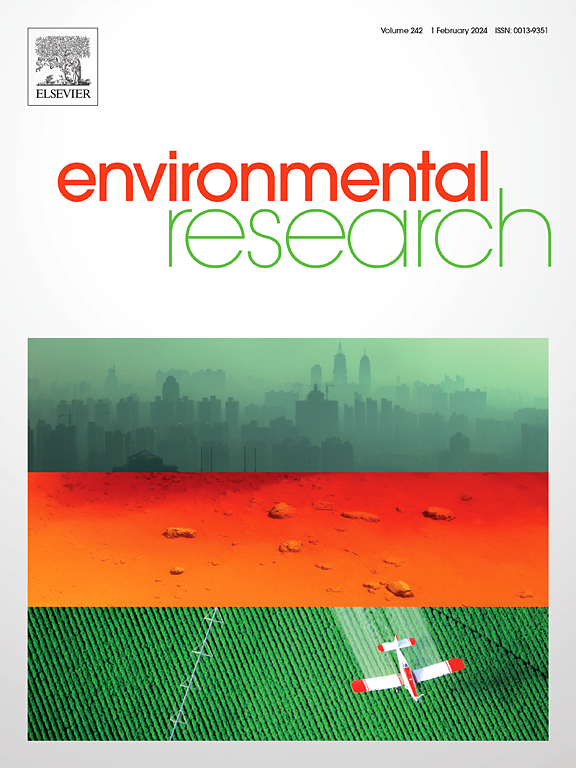Maternal pre-pregnancy overweight/obesity, in-utero exposure to toxic heavy metals, and offspring age at peak height velocity: A prospective birth cohort study
IF 7.7
2区 环境科学与生态学
Q1 ENVIRONMENTAL SCIENCES
引用次数: 0
Abstract
Introduction
Research on in-utero heavy metal exposure shows inconsistent results on offspring pubertal timing. We aim to contribute to understanding the association between heavy metal exposures and age at peak height velocity (APHV), an indicator of pubertal timing, and to investigate the joint associations of heavy metal concentrations and previously known risk factors.
Methods
We included 956 mother-child dyads from the Boston Birth Cohort. Heavy metal concentrations were measured in maternal red blood cells collected 24–72 h after delivery. Offspring APHV was calculated using mixed-effects growth curve models based on repeated height measurements over time. Firstly, we investigated maternal lead, cadmium and mercury level in association with APHV using multivariate linear regression models. Secondly, we estimated the joint associations of maternal pre-pregnancy overweight/obesity (or race/ethnicity) and heavy metal concentrations with APHV, after adjusting for confounders. Thirdly, we applied a Bayesian kernel machine regression (BKMR) model to investigate the association between the heavy metal mixture and APHV.
Results
Overall, prenatal heavy metal exposure was modestly inversely (but not statistically significantly) associated with earlier offspring APHV. Both childhood and maternal pre-pregnancy overweight/obesity were associated with an earlier APHV. Non-Hispanic Black males had an earlier APHV than other race/ethnicity males. Moreover, high lead and cadmium concentrations and maternal pre-pregnancy overweight/obesity were jointly associated with APHV in males only and females only, respectively. The joint exposure of maternal pre-pregnancy overweight/obesity and high lead concentrations were associated with earlier APHV among males, and likewise maternal pre-pregnancy overweight/obesity and high cadmium concentrations with earlier APHV among females. The joint associations of non-Hispanic Black race/ethnicity and high concentrations of lead and mercury with APHV were observed in males.
Conclusions
Our findings suggest that maternal pre-pregnancy overweight/obesity prevention and environmental toxic chemicals control may help attenuate the secular trend of early puberty, particularly among non-Hispanic Black individuals.
孕妇孕前超重/肥胖、宫内有毒重金属暴露与子代最高身高速度年龄:一项前瞻性出生队列研究
子宫内重金属暴露对子代青春期发育的影响并不一致。我们的目的是帮助理解重金属暴露与青春期发育时间指标——峰值高度速度年龄(APHV)之间的关系,并调查重金属浓度与先前已知的危险因素之间的联合关系。方法:我们纳入了来自波士顿出生队列的956对母子。测定分娩后24-72 h采集的母体红细胞中重金属浓度。后代APHV的计算采用混合效应生长曲线模型,该模型基于一段时间内重复的身高测量。首先,我们使用多元线性回归模型研究了母亲铅、镉和汞水平与APHV的关系。其次,在调整混杂因素后,我们估计了母亲孕前超重/肥胖(或种族/民族)和重金属浓度与APHV的联合关联。第三,应用贝叶斯核机回归(BKMR)模型研究重金属混合物与APHV的关系。结果:总体而言,产前重金属暴露与早期后代APHV呈轻微负相关(但无统计学意义)。儿童和母亲孕前超重/肥胖都与早期的APHV有关。非西班牙裔黑人男性比其他种族/民族男性更早出现APHV。此外,铅和镉暴露以及孕妇孕前超重/肥胖分别与男性和女性的APHV相关。孕妇孕前超重/肥胖和高铅浓度的联合暴露与男性早期APHV有关,同样,孕妇孕前超重/肥胖和高镉浓度与女性早期APHV有关。在男性中观察到种族/民族和高浓度铅和汞与APHV的联合关联。结论:我们的研究结果表明,母亲孕前超重/肥胖预防和环境有毒化学物质控制可能有助于减轻青春期提前的长期趋势,特别是在非西班牙裔黑人个体中。
本文章由计算机程序翻译,如有差异,请以英文原文为准。
求助全文
约1分钟内获得全文
求助全文
来源期刊

Environmental Research
环境科学-公共卫生、环境卫生与职业卫生
CiteScore
12.60
自引率
8.40%
发文量
2480
审稿时长
4.7 months
期刊介绍:
The Environmental Research journal presents a broad range of interdisciplinary research, focused on addressing worldwide environmental concerns and featuring innovative findings. Our publication strives to explore relevant anthropogenic issues across various environmental sectors, showcasing practical applications in real-life settings.
 求助内容:
求助内容: 应助结果提醒方式:
应助结果提醒方式:


